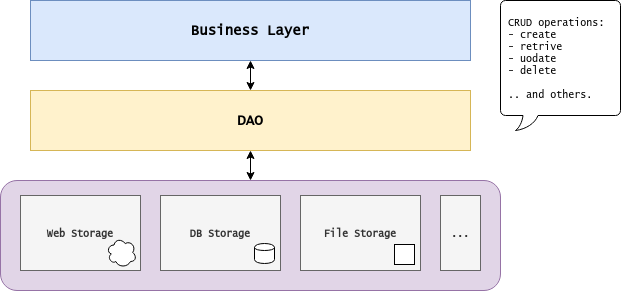The data access object is an arquitectural design pattern. It proposes a layered arquitecture, promoting decoupling of classes containing business logic from data access and corresponding persistence mechanisms:
The generic DAO<T,K> interface describes CRUD operations for a data object of type T and unique key of type K:
public interface Dao<T, K> {
T get(K key);
Collection<T> getAll();
void save(T instance) throws DaoException;
void update(T instance) throws DaoException;
T delete(K key);
int count();
}We wish to have an application that works with a book repository of data.
Our data object is of type Book. The unique identifier is the book's ISBN.
public class Book implements Serializable {
private final String isbn;
private String author;
private String title;
private int year;
public Book(String isbn, String author, String title, int year) {
this.isbn = isbn;
this.author = author;
this.title = title;
this.year = year;
}
//...
}Hence, the BookDao interface can be as follows:
public interface BookDao extends Dao<Book, String> {
/* Aditional operations besides CRUD (inherited): */
Collection<Book> getAllFromAuthorSearch(String queryString);
Collection<Book> getAllFromYearRange(int yearStart, int yearEnd);
}This project contains a command-line interface that allows the user to interact with and underlying repository.
Available commands: GET, ADD, DEL, LIST, SEARCH, RANGE, COUNT, QUIT
Type command > search
Author query? wheeler
Book{isbn='Z6X-4Q9-Z1S', author='Thor N. Wheeler', title='eu, ultrices sit amet,', year=2019}
Available commands: GET, ADD, DEL, LIST, SEARCH, RANGE, COUNT, QUIT
Type command > count
Total records: 100
The application works only with a BookDao interface; the underlying repository can be of different types.
There are three implementations provided:
BookDaoVolatileList- its a volatile implementation. Data is not persisted across sessions.BookDaoSerialization- persists data through java serializationBookDaoTextFiles- persists data through text files (one for each existing book)
Run the program and test the different types of repositories. Note that the client code does not need any modifications (it uses only the interface of the dao).
-
Implement the "range" command in the
CLImethod:///... case "range": /* TODO: implement this command */ System.out.println("[Not implemented]"); break; //...
- The commands retrives the information from the dao using the method:
getAllFromYearRange(int yearStart, int yearEnd)
- The commands retrives the information from the dao using the method:
-
Provide a concrete BookDAO implementation based on volatile storage, using an underlying collection of type
Map<String, Book>.- Name it
BookDaoVolatileMap; - The map key should correspond to the book's ISBN;
- This will be similar to
BookDaoVolatileList, but a little easier to implement. - Change the
mainmethod to use this concrete dao. Everything should work as previously.
- Name it
-
Apply the Simple Factory pattern to allow requesting the different available storage strategies.
-
Pattern participants:
- Factory:
BookDaoFactory - Product:
BookDao - Concrete Products:
BookDaoSerialization,BookDaoVolatileTextFiles,BookDaoVolatileListandBookDaoVolatileMap
- Factory:
-
Change the
mainmethod to use the factory.
-
-
Provide a concrete BookDao implementation that persists data in JSON format.
- Name it
BookDaoJSON; - Download GSON jar library (put it in
/lib) from https://search.maven.org/artifact/com.google.code.gson/gson/2.8.6/jar - Similar implementation to
BookDaoSerialization, but thesaveStorageandreadStorageprivate methods use the GSON library; - Use the following tutorial:
- Name it
Solutions can be found here.
